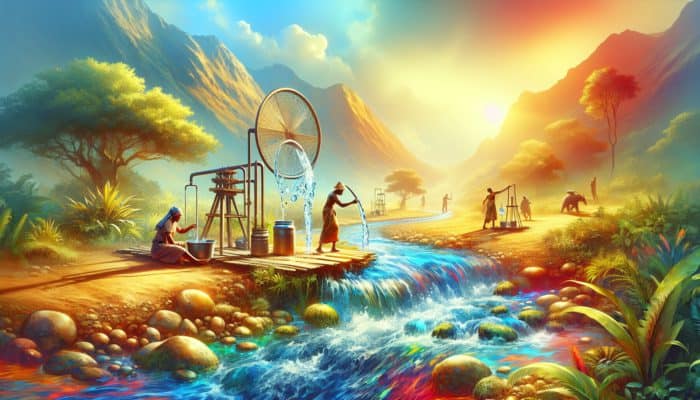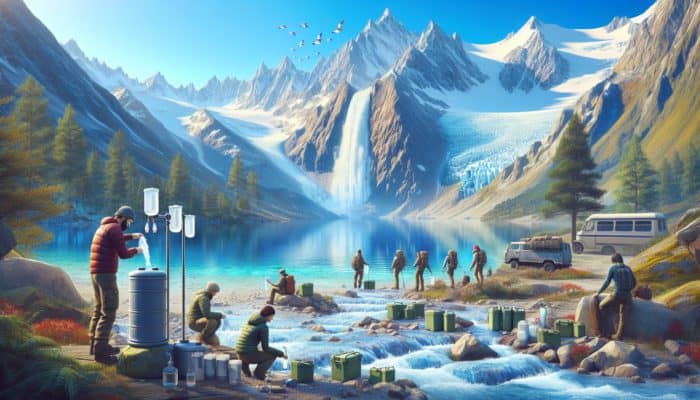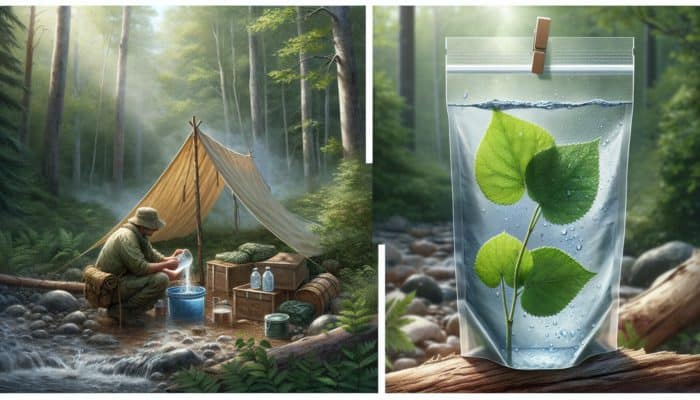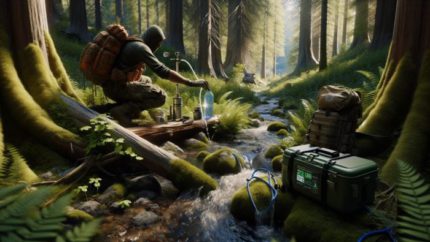Understanding Various Wilderness Water Sources
Exploring the Importance of Streams and Rivers

Wilderness Water Sources: Flowing dynamically through diverse landscapes, streams and rivers are essential wilderness water sources that support both wildlife and human activities. These waterways are often the most accessible option for thirsty adventurers, providing a continuous supply of fresh water. However, despite their abundance, it is crucial to approach these sources with caution and awareness. Streams and rivers can contain a multitude of contaminants, including harmful bacteria and pollutants resulting from upstream activities. Employing effective treatment methods, such as filtration and Boiling, becomes imperative to ensure the water is safe for consumption. Additionally, being mindful of the surrounding environment, such as agricultural runoff or industrial discharges, is vital in evaluating the safety of these crucial resources. Understanding the interplay between local wildlife and water quality can further enhance one’s ability to assess the safety of these indispensable water sources.
When selecting a stream or river for drinking water, it is important to consider factors such as flow rate and geographic location. Typically, fast-handlers are cleaner compared to harbor pools, which can harbor harmful organisms. Observing the water’s colour and clarity can offer valuable insights; for instance, murky water often indicates sediment disturbance or possible contamination. Engaging in these evaluations enhances your chances of finding safe drinking water in the wilderness.
The journey of a river, from its source to its mouth, offers profound lessons in ecology and sustainability. By respecting these vital waterways, we acknowledge their importance in the broader ecosystem, ensuring they remain reliable wilderness water sources for future generations. This respect fosters a sense of responsibility that all adventurers should embrace.
Navigating the Tranquil Waters of Lakes and Ponds
Lakes and ponds, often characterised by their tranquil beauty, present another potential wilderness water source for outdoor enthusiasts. While their stillness and accessibility may seem appealing, these bodies of water come with unique challenges that must be addressed. Lakes and ponds can harbor harmful microorganisms, such as Giardia and Cryptosporidium, posing significant health risks. Therefore, it is critical to approach these sources with an informed mindset.
Assessing the cleanliness of the water’s surface is essential; visible signs such as algae blooms or floating debris can indicate contamination. Before consuming water from these sources, consider employing effective purification methods. Boiling is often recommended, as it is effective, albeit at the cost of energy, despite requiring fuel and time. Alternatively, chemical treatments can also be used, although they might affect the water’s taste.
Moreover, lakes and ponds serve as crucial habitats for various wildlife species, which can complicate their use as sources of drinking water. Observing animal activity can provide insights into the water’s quality; frequent visits by animals may suggest a healthy ecosystem. Understanding these dynamics helps make informed decisions about utilizing these beautiful yet complex water sources.
In summary, while lakes and ponds can be reliable wilderness water sources, they necessitate thorough assessment and treatment to ensure safety. By recognising the unique characteristics and potential risks associated with these bodies of water, outdoor enthusiasts can navigate their adventures with confidence and awareness.
Discovering the Purity of Springs and Seeps
Springs and seeps are remarkable natural features that often emerge as some of the cleanest wilderness water sources available. Typically found in elevated terrains, springs provide a treasure trove of fresh water for those venturing into the wild. While these sources are naturally filtered through layers of earth, they are not without risks, particularly if wildlife frequents the area.
To utilise a spring safely, it is vital to assess the surrounding environment. Look for evidence of animal tracks or lush, healthy vegetation, as these can influence the overall safety of the water. Even when sourcing water from springs, treatment remains advisable; methods such as boiling or using filtration systems can help eliminate any potential contaminants, ensuring your safety.
The experience of sipping clear, cool water from a spring often brings immense joy to adventurers, connecting them deeply to nature. This simple act not only quenches thirst but also fosters a profound appreciation for the environment. As custodians of these natural spaces, it is our responsibility to protect these precious wilderness water sources by avoiding pollution and minimising our impact on the ecosystem.
Utilising Glaciers and Snowmelt as Vital Water Sources

The majestic presence of glaciers and the fleeting beauty of snowmelt offer unique wilderness water sources for those exploring colder climates. These sources yield exceptionally pure water but also present distinct challenges. As glaciers melt, the resulting water may carry debris, necessitating careful filtration to ensure its safe use.
When harvesting water from snowmelt, ensure the snow is allowed to melt completely in a clean container, which helps reduce impurities. In alpine environments, this fresh, cold water can be a lifesaver for travellers, replenishing their supplies and invigorating their spirits. However, it is important to note that the melting process can be time-consuming and energy-intensive.
Furthermore, understanding seasonal changes that affect glaciers and snowmelt is crucial for effective planning. As temperatures rise, the availability of these wilderness water sources can fluctuate significantly. By remaining attuned to the environment and its natural rhythms, adventurers can optimise their chances of finding clean water amidst breathtaking landscapes.
When venturing into the wilderness, the balance of respect and caution ensures that these crucial water sources are utilised sustainably. Engaging with glaciers and snowmelt not only provides hydration but also cultivates a deeper connection to the earth’s natural beauty, reinforcing our commitment to protect these invaluable resources.
Effective Methods for Collecting Water
Optimising Water Collection Using Containers
Collecting water from nature can be a straightforward yet vital experience, particularly when utilising the right containers. The appropriate tools can significantly enhance your ability to source water effectively. Traditional containers, including water bottles or hydration bladders, are specifically designed for mobility and ease of use, making them indispensable for any wilderness adventure. When selecting a container, consider materials that are safe for water storage, such as stainless steel or BPA-free plastic.
It is equally crucial to avoid materials that might leach harmful chemicals into the water. Glass is another safe option, though it is heavier and more fragile than other materials. Regardless of your choice, ensuring that your container is clean before use is paramount to prevent contamination and ensure safe hydration.
Beyond traditional containers, creativity often plays a significant role in survival scenarios. Improvised containers can open new possibilities; for instance, plastic bags can temporarily hold water, provided that care is taken to prevent leaks. Tarps can effectively collect rainwater or dew, transforming simple gear into a valuable resource for hydration.
Understanding the landscape also aids in successful water collection. When exploring, look for natural depressions where water accumulates or areas where rainwater runoff gathers. By employing containers effectively, adventurers can secure reliable access to wilderness water sources while remaining vigilant about sanitation and water quality.
Harnessing Improvised Tools for Water Collection

In the wild, adaptability is a defining trait of survival, and improvised tools offer innovative methods for collecting water, particularly when conventional sources are scarce. Simple items such as tarps or plastic sheets can be ingeniously employed to harvest dew or rainwater. By positioning a tarp at an angle, you can create a surface for condensation to collect and channel into a container.
Moreover, harnessing plant transpiration can be a valuable technique; wrapping leaves or branches in plastic bags allows you to create a micro-ecosystem that traps moisture released by the plant. This method can be particularly effective in arid environments, where every drop of water is crucial for survival.
In addition to natural collection methods, exploring the terrain for existing water sources can lead to unexpected finds. Natural depressions or hollows may fill with rainwater, providing a temporary oasis. By combining observational skills with improvised tools, outdoor enthusiasts can navigate their surroundings effectively and creatively.
While creativity is invaluable, it’s essential to remain aware of the natural environment. Always evaluate the area for potential contaminants to ensure that any collected water is safe for consumption. Improvised tools embody the spirit of resilience in the wilderness, transforming challenges into opportunities for survival and resourcefulness.
Utilising Natural Collection Methods for Water Sourcing
In the pursuit of hydration, natural collection methods can yield rewarding results, particularly during rainstorms or in areas where dew forms overnight. Observing the landscape for natural depressions or hollows can lead to water accumulation that many adventurers often overlook.
Harvesting rainwater represents one of the simplest methods for collecting water in the wild. When storms roll in, positioning a container to capture the falling rain can quickly replenish your water supply. This method not only provides a reliable water source but also allows you to gather fresh, clean rainwater that is naturally filtered and purified.
In addition to rain, dew collection presents another opportunity for hydration. Early mornings are optimal for gathering moisture from leaves and grass; by using a cloth or sponge, you can absorb the dew and wring it out into a container for consumption.
While natural collection methods can be effective, it’s crucial to maintain awareness of the surrounding ecosystem. Minimising impact on the environment is essential to preserving the delicate balance of nature. By employing these techniques, adventurers can tap into the wisdom of the wilderness, harnessing its gifts while fostering a deeper connection with the environment.
Essential Water Purification Techniques
Utilising Boiling for Effective Water Purification
Boiling water remains one of the oldest and most reliable methods for purifying water from wilderness sources. The process is straightforward: bringing water to a rolling boil for at least one minute effectively eradicates most pathogens, including bacteria, viruses, and protozoa. This method proves invaluable in the wild, where access to clean water may be limited.
While boiling is highly effective, it necessitates a heat source, which may not always be readily available. Adventurers should prioritise carrying a portable cooking system, such as a camp stove or lightweight stove, to facilitate this purification method. Always ensure you have adequate fuel to maintain boiling as a viable option throughout your journey.
In addition to its effectiveness, boiling offers the added benefit of being a universal method that can be employed in diverse environments. Whether deep within a forest or atop a mountain, finding a way to heat water can provide peace of mind. The taste of boiled water is often neutral, making it a preferred choice for many outdoor enthusiasts.
However, relying solely on boiling comes with challenges, as time and energy are required to heat water to the appropriate temperature. Therefore, integrating this method with other water purification techniques can enhance overall efficiency. Ultimately, boiling remains a cornerstone of safe drinking practices in the wilderness, ensuring a steady supply of potable water for adventurers.
Exploring Chemical Treatment for Water Purification
Chemical treatments represent another effective method for purifying water sources in wilderness areas. By utilising iodine or chlorine tablets, adventurers can quickly and efficiently decontaminate water. These treatments work by releasing chemicals that target harmful pathogens, rendering water safe for consumption.
While chemical treatment is beneficial, it is crucial to follow the manufacturer’s instructions carefully. Dosage may vary depending on water clarity and temperature, making adherence essential. Additionally, the taste of chemically treated water can be off-putting for some individuals. For those sensitive to flavours, allowing the treated water to sit for a period may help mitigate the chemical taste.
One significant advantage of chemical treatments is their portability. Tablets are lightweight and easy to carry, making them ideal for minimalist travellers. They also require minimal preparation compared to Boiling, which can be particularly advantageous in emergencies.
However, it is vital to recognise that chemical treatments do not eliminate all contaminants. For instance, they may be less effective against certain protozoa. To maximise safety, adventurers should consider combining chemical treatments with other purification methods, such as filtration and Boiling. By adopting a multifaceted approach, outdoor enthusiasts can ensure their water is as clean and safe as possible.
Leveraging Filtration Systems for Water Purification
Portable filtration systems have revolutionised the way outdoor enthusiasts access clean wilderness water sources. These systems come in various designs, including pump filters, gravity filters, and straw filters, catering to different needs and preferences. The primary function of a filtration system is to physically remove contaminants, providing quick access to safe drinking water.
When selecting a filtration system, consider factors such as flow rate, weight, and ease of use. Some models are designed for high volume, while others are compact and ideal for solo travellers. Regular maintenance is essential to ensure the filter remains effective; clogged filters can compromise water quality and safety.
While filtration systems offer convenience, they may not eliminate all pathogens, particularly viruses. Thus, adventurers should consider pairing filtration with additional purification methods, such as boiling or chemical treatments, to enhance safety.
The portability and efficiency of filtration systems make them indispensable for many outdoor activities. Whether trekking through dense forests or navigating alpine landscapes, having access to a reliable filtration system ensures clean water is always within reach. As we embrace these innovations, we build resilience and adaptability, both vital traits in the wilderness.
Critical Safety and Health Considerations
Recognising and Identifying Contaminants in Water
Understanding the landscape of wilderness water sources includes recognising potential contaminants that may be present. Factors such as colour, odour, and visible debris can provide crucial clues regarding water safety. For instance, discoloured water may indicate sediment disturbance or chemical runoff, signalling that caution is warranted.
The presence of unusual odours can also be indicative of contamination; a foul smell may suggest biological activity or pollution. Observing the surrounding environment is equally vital—industrial sites, agricultural runoff, or animal tracks can all point to potential threats to water quality and safety.
When selecting a water source, always trust your instincts. If something seems off, it is better to err on the side of caution. Consider using multiple methods to assess water safety; for example, a visual inspection combined with filtration and Boiling can help mitigate risks and ensure safe hydration.
Emphasising vigilance and awareness empowers outdoor enthusiasts to make informed decisions about their water sources. By remaining attuned to the signs of contamination, adventurers can protect their health and safety, ensuring that their wilderness experiences remain positive and enriching.
Mitigating Risks of Waterborne Diseases
Waterborne diseases pose significant risks in the wilderness, making it essential to prioritise safety when utilising wilderness water sources. Illnesses such as Giardia, cholera, and cryptosporidiosis can result from consuming contaminated water, leading to severe health complications. Proper treatment and storage methods can mitigate these risks, ensuring safe hydration.
Understanding how contaminants infiltrate water sources is crucial. Wildlife activity, agricultural runoff, and untreated sewage can all introduce harmful microorganisms into the water. By being aware of these risks, adventurers can make informed decisions about water sources and the most suitable treatment methods.
When treating water, employ multiple purification techniques to enhance safety. Boiling, filtration, and chemical treatments can work in unison to create a multi-layered approach that effectively neutralises pathogens. Additionally, always store treated water in clean, sanitised containers to prevent recontamination.
Regular hydration is also essential for preventing negative health outcomes associated with waterborne diseases. Monitoring your water intake and ensuring you have sufficient safe water available can help maintain overall health during wilderness excursions. Ultimately, being vigilant about water safety empowers adventurers to navigate the wild without compromising their well-being.
Effective Hydration Management Strategies
Maintaining proper hydration in the wilderness is a cornerstone of outdoor health, especially when relying on water sources in the wilderness. Dehydration can lead to fatigue, reduced cognitive function, and increased risk of injury. Therefore, understanding water needs based on activity level and climate is essential for effective hydration management.
Adventurers should assess their hydration needs, taking into account variables such as temperature, altitude, and exercise intensity. In hot or dry climates, the body loses fluids rapidly through sweat, necessitating increased water intake. A general guideline of drinking at least half a gallon (about two litres) of water daily can serve as a starting point, but individual needs may vary significantly.
Additionally, monitoring bodily signs can provide valuable feedback regarding hydration levels. Symptoms such as dark urine, dizziness, or dry mouth can signal that it is time to replenish fluids. Carrying a portable water testing kit can also help evaluate water quality, providing peace of mind while drinking from wilderness water sources.
By prioritising hydration management, outdoor enthusiasts enhance their resilience in the wilderness. Staying hydrated not only supports physical performance but also fosters mental clarity and boosts overall enjoyment of the natural world.
Planning for Emergency Response in Water Sourcing
In the unpredictable realm of the wilderness, having a plan for water-related emergencies can be lifesaving. Situations may arise when access to safe wilderness water sources is compromised, necessitating quick and effective action. Establishing an emergency response plan involves preparing for various scenarios, such as contamination or limited access to water.
Begin by identifying potential risks associated with your specific wilderness area. Understanding the types of contaminants present and their sources can guide your response. For instance, if you know a nearby stream has been affected by agricultural runoff, having alternative sources identified beforehand can be invaluable for ensuring safety.
In addition to planning, equipping yourself with appropriate gear is essential. Carrying portable purification systems, emergency water tablets, and backup containers ensures that you are prepared for unforeseen circumstances. Familiarize yourself with effective treatment methods, such as boiling or chemical treatment, to enhance your preparedness in emergencies.
Ultimately, preparedness and adaptability are key in navigating emergencies related to water sourcing. By proactively planning for these situations, you can safeguard your health and well-being while fully embracing the wilderness experience.
Understanding the Environmental Impact of Water Collection
Strategies for Minimising Environmental Disturbance
Collecting water in the wilderness should be approached with a focus on minimising environmental disturbance. Sustainable water collection practices help preserve natural habitats and maintain the integrity of wilderness water sources. Each time water is extracted, it is vital to consider the potential impacts on the surrounding ecosystem.
When selecting a water source, prioritise areas with minimal wildlife activity to reduce the impact on local fauna. Additionally, avoid over-extraction from any one source; rotating your collection points allows the environment to recover and thrive. It’s essential to strike a balance between your needs and the needs of the ecosystem, promoting long-term sustainability.
Using natural depressions or hollows for rainwater collection can mitigate disturbance to the surrounding plants and animals while still providing reliable hydration. Engaging with the environment respectfully fosters a deeper connection to nature and encourages conservation-minded practices.
By prioritising minimal disturbance, outdoor enthusiasts contribute to the health of the ecosystems they explore. This commitment to sustainability underscores the importance of preserving wilderness water sources for future generations, ensuring that these vital resources remain intact for all who rely on them.
Implementing Sustainable Practices in Water Collection
Adopting sustainable practices during water collection is paramount for the long-term health of wilderness water sources. As adventurers, we have a responsibility to engage with our environment in ways that preserve its integrity. Sustainable practices not only ensure our immediate safety but also contribute to the ecological balance of the areas we explore.
One effective method is to prioritise collecting from abundant sources while allowing less-utilised areas to recover. Rotating collection points reduces pressure on any single source, promoting biodiversity and ecosystem health. Furthermore, when engaging in natural collection methods, such as rainwater harvesting, you contribute to maintaining the natural water cycle and its vital functions.
Moreover, consider the impact of your gear and water collection methods on the environment. Using reusable containers and avoiding single-use plastics minimises waste and pollution in the wilderness. By embracing a mindset of sustainability, we can foster a culture of conservation and respect for the natural world.
Incorporating sustainable practices into outdoor adventures not only enhances our experiences but also serves as a model for future generations. By caring for wilderness water sources, we contribute to a healthier planet and ensure that these precious resources remain available for all who venture into nature.
Embracing Leave No Trace Principles
The Leave No Trace principles serve as guiding tenets for responsible wilderness exploration, particularly when it comes to wilderness water sources. These principles emphasise the importance of minimising our environmental impact, ensuring that the natural beauty of our surroundings remains intact for future generations.
One of the core tenets is to plan and prepare, facilitating sustainable practices that protect water sources. Understanding the areas you’ll be visiting, including any unique challenges or sensitivities, helps to mitigate potential disturbances and promotes responsible behaviour.
When collecting water, adhere to Leave No Trace principles by avoiding areas with sensitive vegetation or wildlife habitats. Utilise established trails where possible and engage in water collection methods that reduce impact, such as using natural depressions for rainwater harvesting.
Lastly, always pack out any waste, including used filters or containers, to prevent pollution and ensure that your footprint remains light. By embodying these principles, outdoor enthusiasts can foster a culture of stewardship and respect for wilderness water sources, contributing to the preservation of our precious natural environments for future generations to enjoy.
Championing the Protection of Water Sources
Protecting wilderness water sources is crucial for maintaining healthy ecosystems and ensuring access to clean drinking water for future generations of adventurers. As stewards of the land, we bear the responsibility of safeguarding these vital resources from contamination and overuse.
Implementing protective measures begins with raising awareness about the potential risks associated with water sources. Educating fellow adventurers about the importance of minimising disturbances and recognising signs of contamination fosters a culture of responsibility and care.
Additionally, engaging in community efforts to clean up polluted areas or restore damaged ecosystems can have a significant impact. Many organisations focus on preserving natural habitats and protecting water sources; partnering with such initiatives aligns our personal goals with broader environmental missions.
As individuals, we can also advocate for responsible land use policies that prioritise the protection of wilderness water sources. By voicing our concerns and supporting conservation initiatives, we contribute to systemic changes that enhance the health of our natural environments.
Ultimately, protecting water sources is a shared endeavour—one that requires collective action and a commitment to sustainability. Through our efforts, we ensure that future generations can appreciate the beauty of the wilderness and access clean, safe water whenever they venture into the wild.
Strategies for Emergency Water Sourcing
Identifying and Locating Hidden Water Sources
In the wilderness, the ability to find hidden water sources can be a lifesaving skill. When conventional wilderness water sources are unavailable, creative tactics become essential for survival. Nature often conceals water in unexpected places, necessitating a keen eye and resourcefulness to uncover these hidden gems.
One method involves recognising plant transpiration, where certain plants release moisture through their leaves. Wrapping leaves or branches with plastic can create a microenvironment that captures this moisture, providing a valuable water source. Look for plants known for high transpiration rates, such as certain types of ferns or large-leaved plants, to maximise your chances of success.
Digging for water is another option, particularly in arid environments. Beneath the surface, groundwater can often be accessed by digging in sandy or moist areas. While this method may require patience and effort, it can yield fresh water when surface sources are nonexistent.
Additionally, exploring terrain features can reveal hidden water pools. Areas with depressions or rocky outcrops may harbour collected rainwater or seasonal springs. By integrating observational skills with practical methods, adventurers can uncover hidden water sources, enhancing their chances of survival in challenging conditions.
Melting Ice and Snow for Vital Hydration
When the wilderness is blanketed in snow or surrounded by ice, melting these substances can create a valuable source of water in the wilderness. This process may require patience and effort, but the reward is often worth the wait. Melting snow or ice provides fresh water, albeit with certain considerations for safety and purity.
To effectively utilise snow as a water source, ensure it is clean and free of contaminants. Avoid snow that is yellowed or discolored, as this may indicate animal activity or pollution. Once collected, allow the snow to melt in a clean container, ensuring it transforms into a liquid form for safe consumption.
Melting ice presents similar considerations; ensure the ice is clear and free of debris before collection. Additionally, while melting snow and ice provides hydration, it often lacks essential minerals. A balanced approach to nutrition and hydration is essential during prolonged wilderness excursions to maintain overall health.
Incorporating this method into your water sourcing strategy can enhance your resilience in cold environments. By mastering the art of melting ice and snow, adventurers empower themselves to thrive in challenging conditions, ensuring hydration even when traditional sources are scarce.
Implementing Rainwater Harvesting Techniques
Collecting rainwater during storms offers a practical and reliable emergency water source. This method requires minimal equipment and can effectively secure clean, potable water. Understanding the best practices for rainwater harvesting is vital for maximising your yield and ensuring safety.
Positioning containers strategically to catch rainwater can enhance collection efficiency. Tarps, vessels, or even your hands can serve as collection tools, channelling moisture into a container. Ensuring that your collection area is clean and free of contaminants is crucial for maintaining water quality.
Rainwater is naturally distilled and often free of harmful pathogens, making it a preferred source during outdoor excursions. However, proper treatment is still advisable, as airborne contaminants or debris can compromise water quality. Using filtration or boiling methods after collection can further ensure safety and palatability.
Incorporating rainwater harvesting into your wilderness water sourcing strategy can provide peace of mind and enhance your overall preparedness. This method empowers adventurers to utilise the natural elements around them, fostering a deeper connection to the environment while ensuring access to hydration.
Purifying Contaminated Water in Emergencies
In emergencies, the ability to purify contaminated water becomes essential for survival. Utilising wilderness water sources that may not be ideal requires effective purification methods to ensure safety. Familiarity with various techniques can empower adventurers to make safe choices, even in dire circumstances.
Boiling water remains one of the most effective methods for eliminating pathogens. Engaging in this process requires a heat source and time, but it effectively neutralises harmful microorganisms. A rolling boil for at least one minute is typically sufficient to ensure safety, though higher altitudes may necessitate longer boiling times.
Chemical treatment options, such as iodine or chlorine tablets, provide an alternative for those without access to heat sources. However, it is crucial to follow the manufacturer’s instructions carefully and allow adequate time for the chemicals to work effectively. Combining chemical treatments with filtration methods can enhance water safety and improve its taste.
Finally, utilising portable filtration systems can provide immediate relief in emergencies. These systems effectively remove contaminants, ensuring access to clean drinking water. By integrating various purification techniques into your emergency water sourcing strategy, you can enhance your resilience in the wilderness, prioritising health and safety in challenging circumstances.
Maximising the Use of Natural Springs
Natural springs represent a pristine and often underappreciated source of wilderness water. In survival situations, locating and using these springs can be vital for accessing clean water. Springs typically offer naturally filtered water, but caution is still necessary to ensure safety.
To find a natural spring, look for areas with lush vegetation, as springs often support healthier plant life due to their water supply. Observing wildlife activity can also provide clues; animals are instinctively drawn to reliable water sources, so their presence may indicate a nearby spring or stream. Engaging in careful exploration can lead to the discovery of hidden springs that may not be immediately visible.
While natural springs generally provide cleaner water than surface sources, treating the water remains advisable. Using filtration or boiling methods can further ensure safety, particularly if the spring is frequented by wildlife.
By embracing the unique characteristics of natural springs, outdoor enthusiasts can tap into a remarkable resource. Utilizing these springs not only enhances hydration but also fosters a deeper appreciation for the delicate ecosystems they support, reinforcing our duty to protect these precious wilderness water sources.
Effective Planning and Preparation for Water Management
Assessing Individual Water Needs for Wilderness Adventures
Understanding your water needs is critical for effective wilderness planning and preparation. Each individual’s requirements may vary based on factors such as activity level, climate, and terrain. Assessing these needs ensures that adventurers can carry sufficient water and stay hydrated while exploring wilderness areas and accessing water sources.
Start by evaluating your planned activities. Intense physical exertion, such as hiking in mountainous terrain, typically requires more hydration than strolls. High temperatures and arid conditions further necessitate increased water intake, as the body loses fluids more rapidly in such environments.
Establishing a daily water intake guideline can provide a helpful reference. A minimum of two litres (approximately half a gallon) is often recommended; however, individual needs may vary depending on the specific circumstances of your adventure. Carrying portable water testing kits can also help assess water quality, enabling more informed decisions when sourcing water from natural resources.
Regularly checking your hydration levels can enhance self-awareness. Monitoring bodily signs, such as urine colour and overall energy levels, can provide valuable feedback about your hydration status. By proactively addressing your water needs, you empower yourself to thrive in the wilderness while maximising both safety and enjoyment.
Essential Gear for Effective Water Sourcing and Management
Equipping yourself with the right gear is paramount for effective water sourcing and management in the wilderness. While the specific equipment may vary depending on the adventure, certain essentials can significantly enhance your ability to access and purify water sources in the wilderness.
Begin with a reliable water container, such as a stainless steel bottle or BPA-free hydration bladder. These vessels should be easy to carry, lightweight, and durable for outdoor use. Additionally, consider packing a portable water filter, as this can provide immediate access to clean drinking water from various sources.
Incorporating purification methods into your gear is also vital. Carrying both chemical treatment tablets and a portable camping stove will offer multiple options for ensuring water safety. Furthermore, investing in items such as a small tarp for rainwater collection or a lightweight pot for boiling water can enhance your preparedness for unexpected situations.
Ultimately, the goal is to create a versatile packing system that allows for adaptability in the wilderness. By thoughtfully selecting and organising essential gear, adventurers can navigate their journeys with confidence, knowing they are well-equipped to secure safe wilderness water sources.
Frequently Asked Questions About Wilderness Water Sources
What are the most reliable wilderness water sources?
The most reliable wilderness water sources include streams, rivers, lakes, ponds, springs, and melting snow or ice. Each source has its pros and cons, so it’s essential to assess them for safety and purity based on your specific needs.
How can I effectively purify water while in the wilderness?
You can purify water in the wilderness by boiling, using chemical treatments like iodine tablets, or employing portable filtration systems. Combining these methods enhances safety and ensures you have access to clean drinking water.
Is it safe to consume water from rivers and lakes without treatment?
Drinking water from rivers and lakes is generally not safe due to the potential presence of contaminants. Always assess the water’s clarity and odour, and treat it using purification methods before consumption to mitigate health risks.
How much water should I carry while hiking in the wilderness?
A general guideline is to carry at least two litres (about half a gallon) of water per day. However, individual needs may vary based on activity level, climate, and terrain, so adjust your intake accordingly.
What precautions should I take when collecting rainwater?
When collecting rainwater, ensure your containers are clean and free of contaminants. Position them strategically to catch rain, and consider treating the water before consumption for added safety and peace of mind.
How can I identify if water is contaminated?
Contaminated water may appear discoloured, have an unusual odour, or contain visible debris. Always assess the surrounding environment for signs of pollution or wildlife activity that could affect water quality.
What are the common signs of dehydration?
Common signs of dehydration include dark urine, dizziness, dry mouth, fatigue, and increased thirst. Monitoring these symptoms can help you gauge your hydration level and respond appropriately.
Can I directly drink melted snow or ice without treatment?
While melted snow or ice can serve as a hydration source, it’s advisable to treat it before drinking. Ensure it’s free of contaminants and consider boiling or filtering the water to enhance safety.
What is the best emergency purification method for water?
Boiling water is the most effective method for purification in emergencies. Boiling is not possible; chemical treatments or portable filtration systems can serve as viable alternatives.
How can I minimise my impact on wilderness water sources?
To minimise your impact, collect water from areas with minimal wildlife activity, avoid over-extraction from any single source, and adhere to Leave No Trace principles during your outdoor adventures.
Explore our world on X!
Survival Compass Guide: Essential Tips for Navigation
Mastering Compass Navigation: Essential Knowledge and Techniques What is a Compass and Its Importance? Survival Compass Guide: A compass is an indispensable navigational tool that enables individuals to ascertain direction in relation to the Earth’s magnetic poles. This device typically features a magnetised needle that consistently points towards magnetic north, facilitating orientation in unfamiliar terrains. […]
SHTF Hunting Skills: Essential Techniques for Survival
Mastering the Essentials of SHTF Hunting Gaining Insight into Prey Behaviour for Success SHTF Hunting Skills: Understanding the habits and patterns of various animals is fundamental to increasing your chances of a successful hunt. This knowledge is not merely beneficial but essential for survival in any environment, particularly during an SHTF scenario where food sources […]
Wilderness Weather Prediction: Essential Techniques
Comprehending the Dynamics of Wilderness Weather Patterns Key Factors That Influence Weather Variability in Wilderness Areas Wilderness Weather Prediction: The weather in wilderness regions is a multifaceted interaction among numerous elements that can fluctuate dramatically depending on the surrounding environment. One of the most significant factors is altitude; as one ascends, temperatures generally decrease, which […]
Shtf Fire-Starting: Essential Techniques and Tools
Mastering the Fundamental Concepts of SHTF Fire-Starting Comprehending the Essential Fire Triangle Shtf Fire-Starting: The fire triangle is a fundamental concept that anyone serious about SHTF fire-starting must understand. This triangle comprises three vital elements: heat, fuel, and oxygen. Mastering these components is essential for successful fire-starting in any scenario. Without heat, you cannot ignite […]








Reading through your post on wilderness water sources, particularly the vital role streams and rivers play in sustaining both wildlife and our own adventures, brings back memories of my own experiences in the great outdoors. I remember one summer hiking through the Appalachian Trail, where the sound of flowing water was almost as intoxicating as the beauty of the landscapes surrounding me. There’s something inherently refreshing about dipping a water bottle into a clear stream, but your insightful reminder about the necessary caution with such sources is spot on.
The discussion around wilderness water sources is particularly relevant today, especially as outdoor activities see a resurgence. I’ve often found streams and rivers to be both a lifeline and a source of wonder in the wild. However, I agree that vigilance is key. During a recent hiking trip, I encountered a serene stream only to later learn about agricultural runoff in the area, which made me rethink my water sourcing strategies.
Your exploration of wilderness water sources emphasizes the delicate balance between accessibility and safety, a theme that resonates deeply with my own experiences. During my last hiking trip, I relied on a mountain stream for hydration but was reminded of the importance of proper filtration methods. It’s fascinating how the purity of these water sources can vary so dramatically based on factors like proximity to human activity or seasonal changes.
Your exploration of wilderness water sources brings to light a crucial point that often gets overlooked by casual adventurers. The reliance on streams and rivers for hydration can easily lead to complacency regarding water safety. I remember a backcountry trip where I naively filled my canteen at a beautifully clear brook, only to later learn from fellow hikers about nearby farming practices potentially contaminating the water. It’s a stark reminder that our enjoyment of nature often intersects with human impact, sometimes in ways we might not immediately recognize.